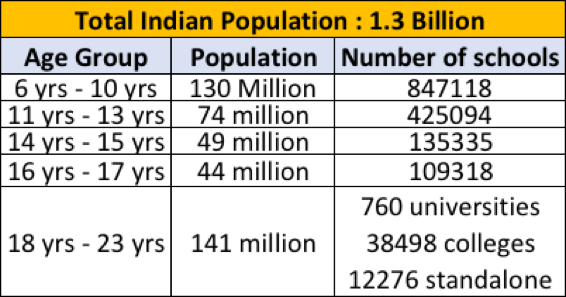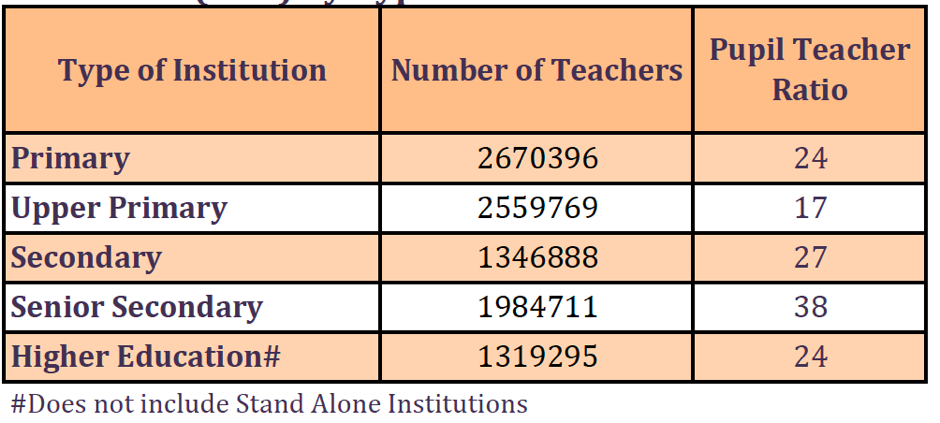Why Blame Indian Education System for our own misplaced aspirations and hypocritical behaviour ?

Whenever I discuss ideas about education platforms, about ed-tech companies or anything related to education sector in India, the foremost thing that is mentioned by everyone is “Dude !!! Indian education system sucks …” . So, like all other tech guys, a couple of years back, my natural tech instinct poked me to google “Problems with Indian Education System” (Go ahead, you can google it now also.. nothing much will change )
And OMG !! the next 20 pages of google search results were full of articles talking about it. It’s been discussed so many times, I thought there must be something really problematic with this system. Rote Learning, Outdated Curriculum, Bad Quality of teachers, education becoming a business and all other types of issues get listed under the Buzzfeed style article headline “10 problems with…”.
This article is my interpretation of the problem in its own way. To have some real findings, I researched what people really expect from the Indian education system and how they want to use it in their real life.
To figure this out, from Feb 2016 — April 2017,
-
I built a data driven career guidance product (not the types of astrology based or IQ test based career counselling…) and launched in a few schools of Tier 2/3 cities as a pilot. Ran it for 3 months before shutting it down after collecting results.
-
Interacted with more than 2000 kids in a coaching kind of setting
-
Interacted with students of different engineering streams as a guest lecturer in reputed engineering colleges in Bangalore
-
Interacted with working professionals of all levels of experiences as lecturer, coach, friend, and even conducted paid sessions (believe me, many of the people really paid a good amount even for few hours of sessions). Even launched online video based coaching program and made some money :-)
-
Hired many college students as content interns from top colleges of Delhi university and asked them to write articles about education system and what they feel about it.
-
Used a few online ed-”tech” products and tried to understand the philosophy behind them.
-
Worked as a consultant for a well funded, well established, rolling in revenue, online education company.
-
Studied various reports and statistics in education sector published by the government and are open sourced for general public.
I am telling the above to let you know that I believe in data and I gathered data to arrive at a conclusion. Yes, Data is just numbers and this is “my” interpretation of the numbers gathered.

Comparing Finland with India — Apples and Oranges
Indian education system has problems and there is no denying the fact. Not only the infrastructural issues, even the teaching methodology needs attention. But then, comparing it with Finland education system is like comparing apples with oranges.
The root of the problem is “Comparison”. That’s the problem every Indian loves to lives with and creates a “rat race” using the phrase “sharma ji ka beta”
Look at the following numbers.


If you compare, the data points are not even comparable. Finland, due to lower population does not face the same issues as India. When a significant population of India struggles for food, clothing and shelter, Finland provides every unemployed person, a significant monthly stipend. Schools are free in Finland. Teaching methodology is different and even, the food is provided for free. Teachers have to go through a rigorous training and need to have certifications to teach students. Even parents trust the school and teacher and play their role in the education of the child by being able to provide the necessary environment of learning.
In India, the enormous size of population, religious and cultural diversity, low per capita income, high inflation, and ever increasing rich and poor divide makes it impossible for people to even make ends meet. Children can study when there is a conducive environment. And that’s what governments need to work on. That’s the problem politicians need to solve. Once the bottom most layer of Maslow’s law is addressed, then only you can see drastic changes in teaching methodologies.
But then, there is one stark difference in these numbers. Observe the number of standalone institutions in both countries. Standalone institutions are the ones that provide vocational or skill oriented education/training. Finland, even being a small country has more number of standalone institutions compared to number of colleges. Where India has almost one-third of the standalone institutions with respect to colleges.
Is it because Finland puts more emphasis on life skills than the usual basic education ? Is it because people in Finland are okay even if they are NOT engineers, doctors or lawyers but ARE mechanics or masons ? India can definitely have more number of vocational institutions but why are these vocational institutions are so less in number ?
May be. but Indians are definitely not okay if they don’t become engineers or doctors or lawyers ? Even artists in India are not a respected lot.
But before generalizing, Let’s consider this. Finland is even less than the size of Bangalore. Even Bangalore population is > 8 million with approximately 1 million IT Professionals working in this city. So, If we wish to imitate or adopt Finland education system, we can try changing Bangalore ecosystem.
But why is it not possible ? May be the next section will clarify that.
From Taxila to Delhi Public School ( The Theory … )
Don’t worry, I am not giving history lecture. I am just using a metaphoric expression. From the ancient times, Indians are known for their pedigree , their intellect, their knowledge of the world and universe. Whenever an Indian reaches a top position across the world, even if she is not a citizen of India by citizenship status, we celebrate. Taxila was famous for education in medicine, engineering, philosophy, political science and all other streams. Apart from gaining all that knowledge, students in Taxila also learnt about warfare, business or skills that can help them earn a living.
Cut to the present world, all of us want our kids to study in reputed schools like Delhi Public School. Why DPS ? Because we believe that DPS can provide the education or knowledge of similar kind while making sure that children also learn the skills so that they earn a living for themselves and have a better life.
But the problem starts here and it is called expectation mismatch. During ancient times, parents respected teachers and sent their children far away from themselves to enable learning. They supported their children and even taught lessons of life at home. But in the DPS generation, parents pay for the tuition and now, it’s the responsibility of the schools to build the all round character of the child.
My kid has all the freedom to make a choice of whatever she wants. But I think she’ll go for engineering as it is a safe career.
The above quote is a real statement made by a parent in Bangalore who works as an senior manager in a well known product company. He is an “ IIT graduate” who has travelled the world and is a self declared “open-minded” person. and he is not only one parent, but this is the same feeling held by almost all of the parents in India.
So, in a well educated and well settled society, kids go to all kinds of classes (swimming, dance, tennis, singing, cricket, football, and now, badminton too… ) till the time they are in 6th class. Come 7th standard, and the number of extra classes decrease. By 9th Class, the extra classes are Physics, Chemistry and Maths. Because the race starts to get into engineering or medicine. There is a social status associated with these two career options. Only if the child is not able to make into these streams that she gets to make a choice of 3rd option available. if no option is available, only then the child gets to do what she actually wanted to do. And that happens, because the parents give up the hope of “success”.
How many people in Bangalore or India who belong to upper middle class and above think of their children becoming teachers?? The answer is “ None !!!! .. “
Because inherently, we do not respect the teaching profession. In India, a large number of teachers exist because they could not get any other mainstream job.
Let’s look at some of the data related to teachers

Out of these numbers, about 65% of the teachers are working in private schools. For Govt. schools, there is a criteria to become a teacher by clearing B.Ed. or D.Ed. exams. But private schools, there is no such criteria. As per govt. reports, approximately 40% of the private school teachers are untrained and 60% of private school teaching staff is not even on permanent rolls.
Another drastic statistics is that 85% of teaching staff in private schools is female. whereas, only 35% of the total teaching staff in government schools is female. This simple number can tell you that teaching job in govt. schools being permanent in nature is preferred by males. but in private schools, teaching staff is mostly female, many of them are on contracts as part time teachers who are teaching because they cannot join the mainstream job scenario.
And, still, the well educated people rush towards private schools for admissions even by paying bribes and capitation fees. Because, the only thing they understand is that by paying money, they buy accountability and get rid of their own responsibilities. When parents should be assisting their children in discovering their career interests, they get rid of their responsibility by forcing the children to go for safe bets like engineering and medicine and put the onus of success on the untrained private schools teachers.

when the results don’t happen, the blame is shifted swiftly to the Indian education system and how adopting Finland education system mechanism can change things.
Let’s look at another data sheet.

This data sheet shows the enrolment percentage for major streams in India at the under-graduate level. Surprisingly, a significant size of population studies arts, humanities and social sciences. Engineering comes as a distant 4th in the list and medicine comes distant 7th.
But as per news reports by intellectuals and educationists, this country has a mad rush towards Engineering and Medicine. isn’t it ?
Let’s read the next section to understand it a bit more…
The Poor Need Education, The Rich Need Safety Net
There are two kinds of India.
First One : the well educated, well earning, living in Tier 1/2 cities , India. Second One : the poor or lower middle class, waiting for month end salary, living Tier 3/4 cities and towns, paying for education through the nose, India.
The first one, the well educated, well earning one is the one creating a rat race. They already have a good life. They can afford to experiment with life and try learning the skills they wish to pursue. But they choose the rat race for engineering and doctor. Because they fear of losing out. They fear of falling the levels in the ladder of Maslow’s law. For them, Engineering and doctor becomes a safe option and thus, creates a safety net of “guaranteed” survival.
The second one wants the education and goes to the government or public schools. For this second one, education is the only means to get a good life. For them, a good life means having a regular stable income to be able to provide for family and jump up the ladder in the Maslow’s law. For them, the regular education is a boon because by studying the regular maths, physics, chemistry , botany, social sciences or english, they’ll be able to join the vocational courses. They’ll be able to become nurses, teachers, lab technicians, mechanics, clerks, and all the other jobs that can get them a decent lifestyle.
when the poor enrol for education in same Indian education system, they become creators, innovators, get their own ideas to work, follow what they are good at, do not depend on others, fight their own battle and finally, are a happy lot.
But then, many a times, looking at the first one, by the law of aspiration and comparison, the upper cadre of second kind becomes the aspirational ones and join the rat race on the basis of various kinds of roles.
Because of this mad rush, the number of vocational institutes remain low. Vocational training is not considered by choice, but because there is nothing else left as an option. The people whom you see joining the arts, humanities and sciences, mostly are the ones who tried for Engineering and Medicine but could not make it. Only a small insignificant population joins the alternative streams by choice.
The only difference is the way people define education. For one, it is the means to maintain a status in society. For second, it is the means to a good life.
Both the types of people complain about Indian Education System. but the poor complains about access to schools and infrastructure and the rich complains about all round development program.
The First type is the one who creates the hype of problem in Indian education system. Where as the second type is busy in learning as much as they can and use the education to uncover their hidden talents of life.
You can decide, what should we blame the Indian education system for ? that the government is not changing the system or that we are not ready to change ourselves ?
To Be Continued with some significant data, facts and figure…
Coming Up Soon : The Saga of Ed-”Tech” Startups in India
Reference Reports & Websites :
